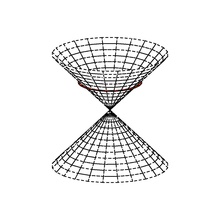|
Null vector In mathematics, given a vector space X with an associated quadratic form q, written (X, q), a null vector or isotropic vector is a non-zero element x of X for which q(x) = 0. In the theory of real bilinear forms, definite quadratic forms and isotropic quadratic forms are distinct. They are distinguished in that only for the latter does there exist a nonzero null vector. A quadratic space (X, q) which has a null vector is called a pseudo-Euclidean space. The term isotropic vector v when q(v) = 0 has been used in quadratic spaces,[1] and anisotropic space for a quadratic space without null vectors. A pseudo-Euclidean vector space may be decomposed (non-uniquely) into orthogonal subspaces A and B, X = A + B, where q is positive-definite on A and negative-definite on B. The null cone, or isotropic cone, of X consists of the union of balanced spheres: The null cone is also the union of the isotropic lines through the origin. Split algebrasA composition algebra with a null vector is a split algebra.[2] In a composition algebra (A, +, ×, *), the quadratic form is q(x) = x x*. When x is a null vector then there is no multiplicative inverse for x, and since x ≠ 0, A is not a division algebra. In the Cayley–Dickson construction, the split algebras arise in the series bicomplex numbers, biquaternions, and bioctonions, which uses the complex number field as the foundation of this doubling construction due to L. E. Dickson (1919). In particular, these algebras have two imaginary units, which commute so their product, when squared, yields +1:
The real subalgebras, split complex numbers, split quaternions, and split-octonions, with their null cones representing the light tracking into and out of 0 ∈ A, suggest spacetime topology. ExamplesThe light-like vectors of Minkowski space are null vectors. The four linearly independent biquaternions l = 1 + hi, n = 1 + hj, m = 1 + hk, and m∗ = 1 – hk are null vectors and { l, n, m, m∗ } can serve as a basis for the subspace used to represent spacetime. Null vectors are also used in the Newman–Penrose formalism approach to spacetime manifolds.[3] In the Verma module of a Lie algebra there are null vectors. References
|




